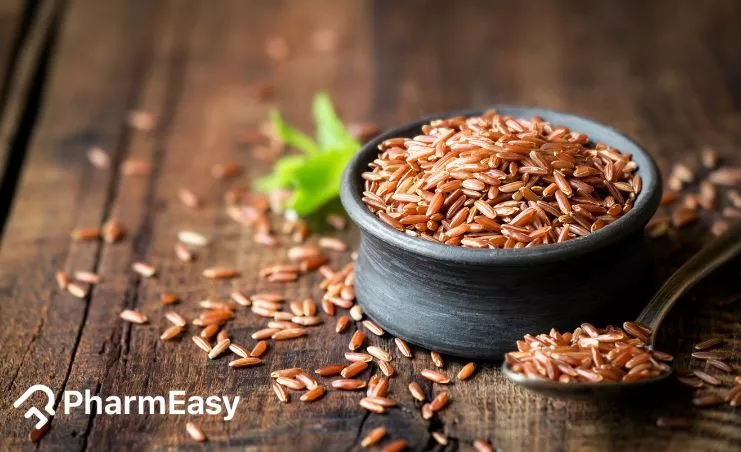Red Rice: Uses, Benefits, Side Effects & More
By Mansi Shah +2 more

Get,

to manage your symptom
Get your,


4 Cr+ families
benefitted

OTP sent to 9988776655



You’ve successfully subscribed to receive
doctor-approved tips on
Whatsapp

Get ready to feel your best.

Hi There,
Download the PharmEasy App now!!


Register to Avail the Offer
Send OTPBy continuing, you agree with our Privacy Policy and Terms and Conditions

Hi There,
Sign up on PharmEasy now!!
Trusted by 4 crore+ families

OTP sent to 9988776655



You have unlocked 25% off on medicines




Code: NU25
By Mansi Shah +2 more
Table of Contents
According to Balinese mythology, a divine bird was sent to Earth carrying four seeds coloured red, white, black, and yellow. During its journey, the bird consumed the yellow seed, leaving only the red, white, and black ones. These are believed to represent the various types of rice grains known today.
Among them, red rice stands out for its distinctive colour and traditional significance. Commonly referred to by different names such as Oryza longistaminata, Matta rice, Palakkadan Matta rice, and Rakthashali in Ayurveda, red rice owes its rich hue to the presence of anthocyanin, a natural antioxidant pigment.

Red rice can appear in several forms, which include wild, weedy, or cultivated and may be partially or fully covered with husk. It has been traditionally cultivated in regions such as Sri Lanka, China, the United States, Korea, and India. Within India, red rice is grown in various states, including Karnataka, Tamil Nadu, Kerala, Odisha, and Madhya Pradesh. Notable varieties include Patni from Maharashtra, Matali and Jatu from Kullu, and Matta from Kerala1.
Did You know?
Red rice is a nutritional powerhouse. It contains proteins, carbohydrates, mono-unsaturated fatty acids, vitamins, and minerals like zinc and iron. Additionally, red rice is a source of polyphenols, including vanillic acid and ferulic acid, as well as antioxidants like anthocyanins, proanthocyanidins, and flavonoids, which are responsible for its characteristic colour. The nutritional components of red rice per 100 grams are given below2:
Scientific studies have examined various aspects of red rice, and its consumption has been associated with several beneficial nutritional properties. Some of these observed characteristics are outlined below, based on available research and traditional dietary usage.
Some of the potential benefits of red rice are described as below:
Inflammation is the body’s natural defence mechanism in response to infection, stress, or tissue injury. It can be acute, such as in the case of fever, or chronic, as seen in long-term conditions like arthritis. A systematic review12 has reported that red rice may exhibit anti-inflammatory and antioxidant properties in certain experimental settings. Antioxidants are known to help protect cells from oxidative stress and may assist in reducing inflammatory responses. These potential effects are attributed to the presence of naturally occurring compounds in red rice, such as gamma-oryzanol, flavonoids, and phenolic compounds3.
While such findings are of interest, it is important to note that more robust scientific studies are needed to confirm these observations. At present, there is insufficient clinical evidence to support any definitive health claims regarding the management or treatment of inflammatory conditions through the consumption of red rice.
Breast cancer is one of the most commonly diagnosed cancers affecting women worldwide. Some preliminary research13 has investigated the potential effects of red rice on breast cancer cells in laboratory settings. Findings from these studies suggest that certain compounds present in red rice, such as polyphenols, particularly proanthocyanidins may influence cellular processes related to cancer progression. For example, red rice extracts have been observed to inhibit the activity of interleukin-6 (IL-6), a protein associated with cell growth and may also play a role in reducing cell migration in vitro4.
However, it is important to emphasise that these studies are experimental in nature, and the results have not been confirmed through large-scale clinical trials. At this stage, there is no conclusive evidence to support any preventive or therapeutic claims related to breast cancer, and further research is required. Individuals should consult with qualified healthcare professionals for medical advice or treatment..
Alopecia is the loss of hair or baldness. Red rice is naturally rich in protein and other nutrients, which are important for general health, including the maintenance of hair. Some experimental research5 has explored the potential impact of red rice on hair health. In one such study, red rice extract was found to inhibit the activity of the enzyme 5-alpha reductase, which is associated with hair loss in certain conditions. These findings suggest a possible link between compounds found in red rice and reduced hair shedding in laboratory models. However, these results are preliminary and have not been confirmed through extensive human studies. At present, there is insufficient scientific evidence to support the use of red rice in managing alopecia, and individuals experiencing hair loss are advised to seek guidance from a qualified medical professional.
Type 2 diabetes is characterised by elevated blood glucose levels either due to a decreased insulin level or resistance of the body to insulin (a hormone that regulates blood glucose levels). A study6 in 2020 investigated the potential effects of red rice in a diabetic mouse model. The findings suggested that red rice consumption may be associated with improved insulin sensitivity and a lower glycaemic response in that experimental context. These observations were attributed to the naturally low glycaemic index of red rice and the presence of certain bioactive compounds. While these results are scientifically noteworthy,
it is important to recognise that the study was conducted on animals, and further well-designed clinical trials in humans are necessary to confirm these outcomes. At present, there is not enough evidence to support any definitive health claims regarding the management of Type 2 diabetes through red rice consumption. Individuals with diabetes should consult a qualified healthcare provider for appropriate dietary and medical guidance.
Dyslipidemia is characterised by elevated cholesterol, including increased low-density lipoprotein, often referred to as ‘bad’ cholesterol, and decreased high-density lipoprotein (HDL), known as ‘good’ cholesterol. A review of existing research7 has noted that red yeast rice, which is a fermented form of red rice, may help reduce cholesterol levels by inhibiting its synthesis in the body.
Additionally, the presence of naturally occurring phytosterols and monounsaturated fatty acids in red rice has been associated with potential benefits in managing lipid profiles. These findings suggest that red rice might have a positive effect on dyslipidemia8. However, further rigorous studies are required to establish these claims with greater scientific certainty.
Literature indicates that diets rich in dietary fibre are generally associated with a reduced intake of fats and may contribute to improved digestive health. Traditional Chinese medicine has historically used red rice as a natural help for digestion8. As a good source of dietary fibre, red rice may support regular bowel movements and provide relief from constipation. Furthermore, red rice is naturally low in fat while being relatively high in protein and fibre, which can promote feelings of fullness, potentially reducing overeating and supporting metabolic health. These characteristics suggest that consuming red rice could be beneficial for digestion, relief from constipation, and maintaining a healthy weight1. However, further scientific studies are needed to confirm these effects.
Though there are studies that show the benefits of red rice in various conditions, these are insufficient and there is a need for further studies to establish the true extent of the benefits of red rice on human health.
As red rice is a good source of many nutrients, including phytochemicals, which are believed to possess properties that may support skin health and potentially contribute to anti-ageing effects15.
Dr. Rajeev Singh, BAMS
You must consult a qualified doctor before taking any herbal supplements. Do not discontinue or replace an ongoing treatment of modern medicine with an ayurvedic/herbal preparation without consulting a qualified doctor.
Also Read: Puffed Rice: Uses, Benefits, Side Effects By Dr. Rajeev Singh
Few side effects related to the consumption of red rice include:
However, if you experience any adverse reactions to red rice, it is advised to discontinue its use immediately and consult a doctor or the Ayurvedic physician who prescribed it. They can provide appropriate guidance based on your symptoms.”
Certain studies14 have explored the potential of red yeast rice in supporting bone health. Preliminary findings from these studies suggest that red yeast rice may have a role in promoting bone formation.
Dr. Siddharth Gupta, B.A.M.S, M.D (Ayu)
Eating red rice is okay if taken in moderate amounts. However, general precautions must be followed in the following conditions:
Also Read: Plums (Aloo Bukhara): Uses, Benefits, Side Effects & More!
Therefore, you must always seek the advice of your Ayurvedic physician about the possible interaction of red rice with other drugs and follow the prescription thoroughly, as they will know your health condition and other medications you are taking.
Also Read: Clove (Laung): Uses, Benefits, Side Effects and More!
Red rice is a nutrient-rich grain with potential health benefits supported by both traditional knowledge and preliminary scientific studies. While promising, its therapeutic claims require more clinical evidence for confirmation. As with any supplement, it should be consumed with caution and professional guidance.
Yes. In comparison with white rice, red rice is rich in zinc and iron which may offer several health benefits.
Some famous red rice varieties include Patni of Maharashtra, Matali and Jatu of Kullu, and Matta of Kerala.
Yes. Red rice is low in fat and high in protein and fibres, which increases satiety and reduces overeating, which may help in weight loss.
If red rice is fermented consumed improperly, it may be associated with a risk of liver injury. Excessive intake of red rice can lead to digestive discomfort, including indigestion, bloating, and stomach pain, primarily due to its high fibre and protein content. While red rice consumption is generally not known to cause allergic reactions, in some cases, it may be linked to symptoms such as itching, rashes, or swelling. The precise causes and mechanisms underlying these reactions are not yet fully understood.
Disclaimer: The information provided here is for educational/awareness purposes only and is not intended to be a substitute for medical treatment by a healthcare professional and should not be relied upon to diagnose or treat any medical condition. The reader should consult a registered medical practitioner to determine the appropriateness of the information and before consuming any medication. PharmEasy does not provide any guarantee or warranty (express or implied) regarding the accuracy, adequacy, completeness, legality, reliability or usefulness of the information; and disclaims any liability arising thereof.
Comments

Leave your comment...
You may also like
Comments